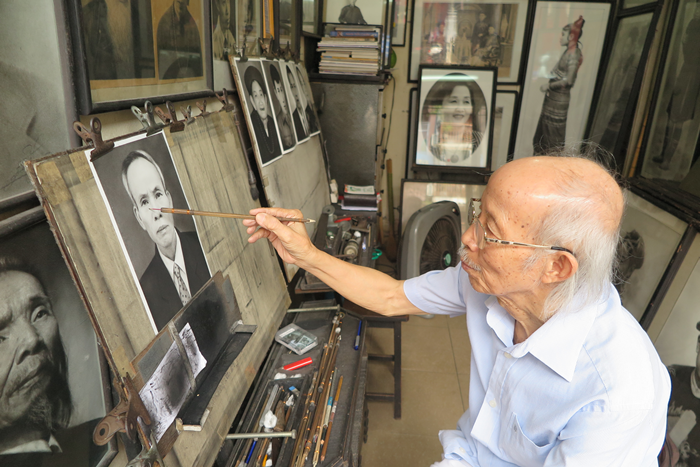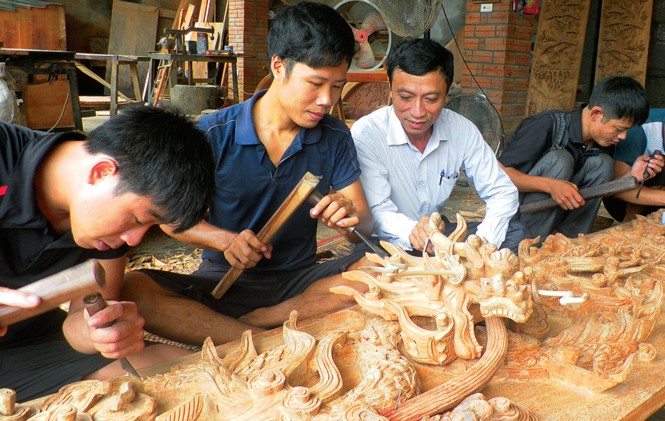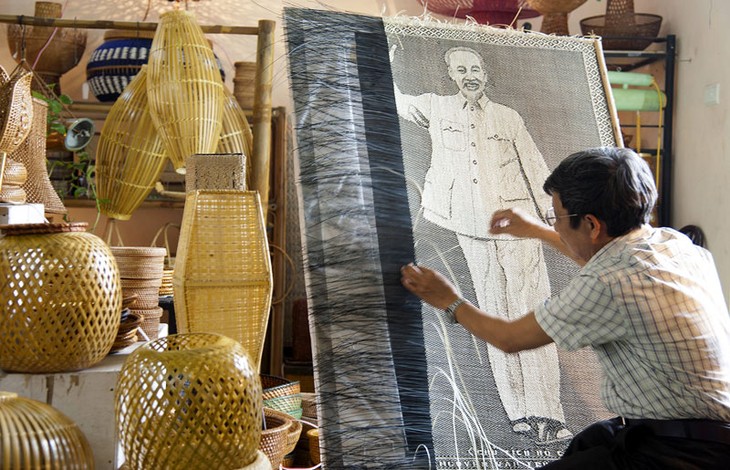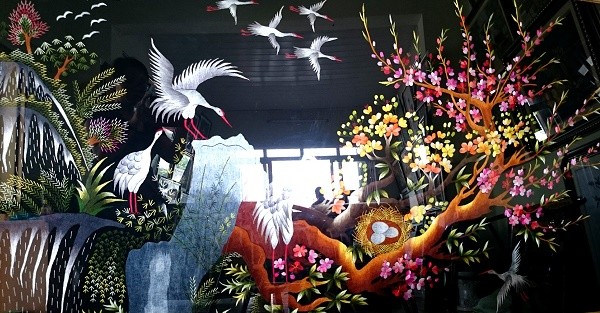B: From the US, Richard Nowak emailed us his feedback for a program on June 30 on 7315 khz. He listened with a Philco Tropic tube receiver hooked up to an outdoor active loop antenna and rated reception all 5s.
A: He congratulated Vietnam on signing the EU-Vietnam Free Trade Agreement, which will remove 99% of import tariffs. Richard said the Sunday Show, as usual, delivered great insight into the culture of Vietnam. It was about Hanoi’s Old Quarter and the handicrafts produced there. Streets there are associated with handicrafts. One street has been a center for jewelry for a hundred years.
B: The Sunday Show also introduced a street where portraits are painted. An interesting interview discussed how portrait art flourished in Hanoi during the 1960’s and 1970’s, according to Richard. Now portraiture is on the brink of disappearing due to digital photography. Richard said he hopes people will rediscover an appreciation for portrait painting. They are much more interesting than digital photography.
 Portrait artist Nguyen Bao Nguyen at his house in Hanoi's Old Quarter. Portrait artist Nguyen Bao Nguyen at his house in Hanoi's Old Quarter. |
A: Handicraft production can hardly compete with mass production. But people still prefer craft products for their uniqueness produced by magically skillful working communities. Over the last decade, the Vietnamese government has adopted many policies and programs to revive traditional crafts and increase income for craftsmen.
B: Vietnam has more than 5,400 craft villages spanning 50 different trade groups. Their products are exported to 160 countries and territories around the world, earning 1.7 billion USD a year. Since May, last year, Vietnam has implemented a “One Commune, One Product” (OCOP) program to help localities develop their principal product.
A: The “One Commune, One Product” program focuses on developing one strong agricultural or non-agricultural product or service in each locality. Originated by Japan’s Oita village more than 30 years ago, the movement has achieved great success and spread to many countries.
 Chang Son craftsmen. Chang Son craftsmen. |
B: Hanoi has the most craft villages in Vietnam. Each is involved in a trade such as ago-forestry product processing, lacquer painting, mother-of-pearl inlays, rattan weaving, embroidery, metallurgy, mechanics, sculpture, garments, textiles, or bonsai.
A: Many craft villages have built a trademark – Chàng Sơn wood furniture in Thạch Thất district, bamboo and rattan weaving products in Chương Mỹ district, and Bát Tràng pottery in Gia Lâm district. With a fame that has remained strong over 1,000 years, Bat Trang Pottery village crafts the most delicate, most valuable ceramic products in Vietnam. Bat Trang products are popular nationwide and have been exported to many countries. The village sells both mass produced products and products 100% hand-made by skilled artisans.
 An artisan is weaving a rattan work of President Ho Chi Minh. An artisan is weaving a rattan work of President Ho Chi Minh. |
B: If you love Vietnamese bamboo and rattan items, you’ll love a trip to Phu Vinh rattan and bamboo village. For 400 years, villagers there have been refining the techniques of making beautiful, high-quality rattan products. In an age that increasingly rejects plastic in favour of natural materials, the delicate products made in Phu Vinh village will nicely compliment your home. You’ll find rattan chairs, tables, sofas, lampshades, vases, and many decorative items.
A: Many Phu Vinh bamboo and rattan products are made of extremely thin strips woven with a small awl as if embroidered and fashioned into fruit baskets, trays, plates, bags, suitcases, sandals, hats, lamp shades, and flower vases. Even portraits and landscape paintings can be recreated in bamboo and rattan.
 A two-sided embroidery art work produced by Quat Dong villagers. A two-sided embroidery art work produced by Quat Dong villagers. |
B: Quat Dong embroidery village is a 400-year-old village which used to serve the royal family. There are other embroidery villages in Vietnam, but Quat Dong is famous for its wonderful two-sided embroidery artworks made of thin chiffon fabric. Both sides of the embroidery are equally beautiful.
A: Sanil Deep of India sent us a reception report for a program on May 19th on 12020 khz. Reception was fairly good with SIO at 343. There was slight fading. Sanil wrote: “Your news bulletin is informative and educative. I’m getting up to date information inside and outside Vietnam. I’m very much enjoying Vietnamese songs and music as well as your manner of presentation.”
B: Sanil told us that he has been a Dx’er since 1982 and so far has collected QSL cards from 150 radio stations in 109 countries. He is also a ham radio operator. He just retired as a senior manager of Kerala Gramin Bank in Calicut.
A: Abdul Mannan of Bangladesh said he listens to our program every day from 16:00-16:30 UTC. “Reception is very good. The Letter Box is my favourite program. A few days ago I received a small embroidered bag from you.”
B: We hope you liked it. In addition to Tshirts and caps with the VOV5 logo, we send many kinds of handicraft items to our listeners as special gifts from Vietnam: folk paintings, key chains, book marks, and figurines of women in ethnic costumes.
A: Andrew Kuznetsov of Latvia sent us a reception report for a program on June 12 on 7280 khz. The signal was good with SINPO at 44544. Andrew noted detailed program contents including the news bulletin, the Current Affairs segment titled "Vietnam Ventures Summit for Vietnamese startups", and the Letter Box review listeners’ letters.
B: Abid Hussain Sajid of Pakistan sent us reception reports for several programs in June. He told us: “I enjoy listening to your broadcasts. All the programs are lively and informative about Vietnam and the its culture.”
A: Here I have a letter from Fumito Hokamura of Japan. He tuned in to our program on May 8th on the frequency of 9840 khz. He said the Current Affairs segment on the US-China trade war was informative and the Letter Box was interesting with its feedback from listeners.
B: Ron Taylor of Texas in the US posted on our website: “I have been restoring an old Hallicrafters SX-71 receiver and was pleased to be able to receive your VOV program on it using only a long wire antenna. This was at about 8:40 pm CST on June 19. Frequency was approx 7220-7225 khz. The last of the program that I listened to spoke of the fruits grown in Vietnam. The signal strength was good, low noise, very little fading. However I did lose the signal after just a few minutes of listening when I believe another station here in the US came on the air.”
A: We are sorry for the inconvenience. But you can listen to the show again on our website: vovworld.vn. This week we also acknowledge reception reports from Shyamal Kumar Banerjee of India; Dildar Ahmed Laghari of Pakistan; Muhammad Aqeel Bashir, head of Pakistan’s Pak Listeners Club; and Howard Lien of the US.
B: Thanks to all listeners for tuning in to VOV. We’ll send you QSL cards to confirm your reports. We welcome your feedback at English Service, VOVWorld, Voice of Vietnam, 45 Ba Trieu Street, Hanoi, Vietnam. Our email address is englishsection@vov.org.vn. Thank you for listening to VOV on shortwave and following us online. Goodbye until next time.